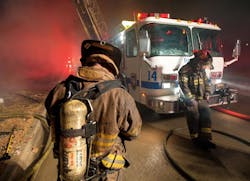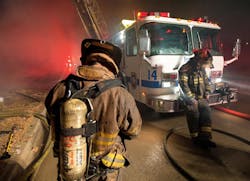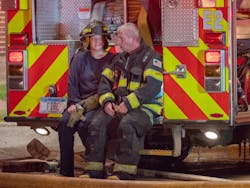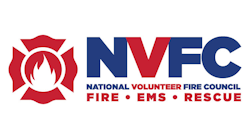This month, we aren't going to any crashes, fires or rescues—but I am going to share with you some things I’ve learned that I am hoping you will learn. Some pretty important stuff. Stuff I did not think was very important just a few years ago. The stuff that may happen after the crashes, fires and rescues...or may just be part of everyday “firefighter” life.
Remember when the character “Ronald the Arsonist” in the movie “Backdraft” said, “The funny thing about firemen is ... Night and day they are always firemen.”
More than a few things have changed in our fire service since that 1991 movie, and some have not. I know that I personally, am not the same person I was in 1973, as a probie or in 1980 as a company officer, or as a chief in 1982. Nor am I who I was in 2000, or even just a few years ago in 2015. Who I am is a combination of all I have experienced since that first day in 1973. We evolve. Hopefully, we evolve in a good way—learning from the good and the bad, correcting, adjusting and moving forward. That's the goal.
And while we still count on good, well-trained firefighters using trained skills and water to deal with the problem of fire, the understanding of who those firefighters are has changed.
Absolutely, firefighters—night and day—are firefighters, but what we knew about the impact of the calls we go on and the lives we lead is much, much different.
When I started in 1973, we really didn’t talk about the bad stuff or we used humor, sometimes really dark humor, to help take the edge off. The dark humor stuff works for me, but that’s me. That’s not everyone.
We need to understand that I or we are not you, him or her.
So, what’s the secret to dealing with the bad stuff we see, respond to and deal with? What about the so called “regular” life stuff that challenges us? How do we manage our mental health, our emotional well-being and behavioral health so we are “OK” when dealing with either personal or response-related “bad stuff”? How do we not drink, smoke, dope, or drive ourselves to death—unintentionally or intentionally? How do we not harm ourselves when the pain gets “that” bad?To be clear, I am only qualified to give you my highly unqualified opinion. I'm no doctor or behavioral health specialist. No way. Not even close. I don’t have a whole lot of alphabet letters after my name. All I have is years of doing, watching, experiencing, screwing up, learning, and keep doing. And, I do get to write about stuff and give my opinion, mostly when asked or in this monthly column. Each month, I have guests share “their” close call and together we discuss what happened and what was learned from it. This month I am giving you my opinion on dealing with stuff that most of us as firefighters and officers are 99 percent unqualified to deal with, but yet have to deal with. We deal with it as peers and we deal with it as fire officers. And this is a subject we get many letters and calls about.
Fish tales
I think the way each of us, as individuals, understand and/or deal with the bad stuff is like eating fish. Some people LOVE to eat fish. They can eat it all day-in sushi, in salad, on the grill-they love fish. Some people CANNOT STAND fish. That would be me. Growing up outside of New York City, when I was about a foot or two tall, my Dad would take me to the deli, and staring at me in the refrigerator glass cases were dead fish heads. Apparently, that was appetizing to some. But to me, these gold-colored fish, whole dead fish, looking right at me did nothing to trigger anything other than running like hell. So, I guess due to that “trauma” I don't like fish. The looks, the smells, the head…the whole thing! Can’t stand it! It doesn't make me right or wrong, I just can’t stand it.
Why? Because we are different for a variety of reasons. In my mind, it is that simple and has helped me understand how to be a better fire officer. So, let’s talk more about us.
Us is we and we all like, don't like or simply hate different stuff. Some like Italian food, others do not. Some love Chinese food? Others? Fuhgeddaboudit. Some people are chilly in a room and others are sweating. Some love the smell of freshly cooked cabbage and most of us don’t. Some like the only real kind of music, country & western, while others like hard rock, jazz, ska (Google it) or rap. Some cry at movies while others are looking around and thinking “What the hell are they crying about!?” Some people think a certain comedian is funny and some, not at all.
Some do this...and some do that. I say tomato, you say tah-mah-toe.
In my sometimes (to a fault) simple way of seeing things, the sooner we (fire service peers and bosses) realize that we are all different and deal with stuff differently, the better off we will be. To even think that there is one way of dealing with the bad stuff is to shove fish down everyone's throat—it just won’t work.
To expect some people to “tough it out” may work, but for others, “toughing it out” is not in their programming and quite frankly impossible as a solution. Forget tough, think big strong people who cry at holiday puppy commercials. They are VERY tough, but bring out those puppies, grandkids or little kids and the tough get a little less tough.
Toughing it out in 2019
It is 2019 and I’m not sure that the term (and actions of) “toughing it out” even applies any longer. There is valid concern about behavioral health issues and the significant impact it has on firefighter wellness. It is real. The stresses faced by firefighters on incidents involving kids, violence, our past (such as veterans) and the role of being a firefighter (making the runs) can have a cumulative impact on our mental health and well-being. Life itself can be overwhelming as well.As someone pretty engaged with the fire service, I love keeping an eye out for “that” new idea. Maybe it's a new way to deliver water or a more effective siren. Maybe it’s a system of managing our fire department policies. Or maybe it’s something to help our people—and even perhaps us—understand our unique and diverse behavioral health needs and challenges.
I have seen numerous folks write articles and offer seminars on fire service behavioral health, which, as long as they are professionally vetted and qualified, is great. But the problem I noticed was trying to get folks to attend some of these programs. If we held a class on venting a roof using your bare hands and teeth while wearing a video camera that automatically posts you doing it on social media, it would be sold out. A class on behavioral health...not so much.
The new generations
We love talking about Millennials, so let's do that. Like it or not, they are the ones in our academies, firehouses, turning out, responding, treating patients, stretching lines and throwing ladders. But they are different. So are Xennials.
Confused? Let me help you:
- Gen Z, iGen, or Centennials: Born 1996 – 2010
- Millennials or Gen Y: Born 1984 – 1995
- Xennials: Born 1977 – 1983
- Generation X: Born 1965 – 1976
- Baby Boomers: Born 1946 – 1964
- Traditionalists or Silent Generation: Born 1945 and before
Most Millennials were between 5 and 20 years old when the 9/11 terrorist attacks happened. Most members of Gen Z have little or no memory of the event. Millennials also grew up during the wars in Iraq and Afghanistan, which helped create our current political environment. Most Millennials were between 12 and 27 during the 2008 election and helped elect our first black president. Millennials are the most racially and ethnically diverse adult generation in our history. Yet the next generation – Generation Z – is even more diverse. So, hold on. Tight.
In the last couple of years, Millennial’s have become the largest generation in the North American workforce. Millennial’s are also the fastest-growing generation of so-called customers in the marketplace. As you may have noticed, Millennial's exhibit different attitudes toward employment, sales and marketing, which is challenging to what you may find as normal. Your normal.
As I mentioned before, Millennials have another group coming up behind them. Known as Gen Z, Generation Z, iGen, or Centennials, this new group of people is making big waves in areas such as parenting, education, employment, entrepreneurship, sales, marketing, politics, religion, and more. It can be exhausting. But it’s just change, creating a group of people that seems “different.” And that’s always happened, and always will.
They are different just like I was different to the World War II firefighters who raised me. And how you were different than say, the Vietnam-era firefighters who raised you. Different is nothing new but identifying how to communicate with them is.
Those Millennials in your firehouse may very well be part of the overall smartest generations ever. However, I think an area that they are “different” is their face-to-face communication, if some even do it. I am not slamming them or anyone, just saying they are different. But the fact is that they have grown up with a communication system that we didn’t have—they can email, text, tweet or whatever without ever having to face a living, breathing person...and in some cases, they communicate wonderfully.
Even more cool is that they can even prepare a message, edit it, re-write it or even delete it compared to me, when I would run my mouth as a young firefighter, and whatever I said was out there. Verbally...but forever. So, while the “editing” or “deleting” part may be cool, it’s still that lessening of the “human” face-to-face stuff that worries me, especially when it comes to firefighters dealing with the “tough” stuff.
So, what do we do?
Your department has an obligation to have behavioral health and wellness “service” to train, educate and then serve the members. A service that the members are comfortable dealing with. I’m not talking about some local government “generic” employee assistance program (EAP) service, but one with people who fully understand and appreciate what we do and what we see. People who have done their “homework” so that we are relatable, and they are relatable to us and they can meet the very specific individual needs of firefighters. People who understand our historic “stigma” of asking for help.
There are many well-regarded services to assist us in this challenging endeavor, including:
- The IAFF Center of Excellence for Behavioral Health Treatment and Recovery
- The NVFC "Share the Load Program"
- The Rosecrance Mental Health & Substance Abuse Center
- Safe Call Now
- The Counseling Team International
Something different
I recently had a discussion with my Fire Fighter Close Calls partner Gordon Graham (retired law enforcement commander, attorney and risk management expert) about something he found that deserves discussion here.
Consider the challenges your company officers face with their day-to-day duties. What support do you give your officers in dealing with members dealing with alcoholism, anger management, depression, family issues, financial fitness, mental toughness, psychological first aid, post-traumatic stress, resilience and sleep challenges? The answer isn’t that the company officers should be experts, but they should know the warning signs and what to do about it. Your officers need to be as ready to “size up” those issues as they would be when turning out on a fire call.
Gordon asked me if I was aware of something called Cordico. I had not heard of Cordico (and their unique firefighter app developed by a PhD and team) but took time to learn about it. We have shared items in this column that I personally think you should check out for no other reason than it looks like a good idea, and the ones I mention this month are no exception.
You would have to be living under a rock to not understand that firefighter behavioral health, wellness and well-being are of great importance, and that the high rates of acute and chronic stress, trauma, depression, suicidal thoughts, and suicide experienced in the fire and EMS field professions are of great concern.
The challenge most fire chiefs and commissioners face is what to do about it. What else can they do to support their personnel? I was surprised when I found that one solution is an app. Seriously?
I immediately became cynical and acted my age. I instantly didn’t like anything that wasn’t something I was uncomfortable with. But then I calmed down and took a look. An app?
As I dug into Cordico, I learned that the technology allows for both anonymous and confidential access. It is a completely confidential app—no one knows that your personnel are using the app or what they are doing with it. That's a big deal for today’s firefighters, fire officers, and all of us. The app also provides you, your officers and especially your members professionally developed tools to allow them to privately and immediately identify potential problems and suggest local solutions.
When we reach out for help, we need ourselves sized up. Think about the crew inside, and command outside. The crew inside may think they are making good progress but, on the outside, conditions are getting worse. It takes both views to best understand the situation.
Think of it this way: Thermal imaging cameras provide us an opportunity to determine if a problem exists, and if so, where we should direct our resources. And while seeing or even speaking with a counselor or professional who understands what we do is of value, we have found it challenging to get people to go there. To make the call, make the appointment, get in the car and go meet face to face. It can be a very significant barrier in getting assistance.
A counseling service, a specific firefighter behavioral health service, or even an app in the hands of your officers and your personnel provides a virtual “thermal imaging camera” that allows a self “size-up” in the comfort of their home, firehouse or literally anywhere. It is also a critical tool for the company officer, when noticing that something may just be a bit “off” with one of the crew members.
A firefighter’s 9-1-1
The ability to reach out when you (me/we. us or them) may need help is critical. It may be a conversation, a phone call or an appointment with any of the highly respected groups we’ve identified or even in a professionally developed and vetted app. What drew my interest is that this app is an option for firefighters when they may be thinking about their own well-being. It allows them to utilize current information to quickly and properly perform a personal size-up. Used along with the services your department may currently provide, it is a very personal tool that can be used without worry of judgement or the requirement of interpersonal communication. Apps have become a way of life in our world and may be a valuable tool in helping firefighters in 2019. Those “different” firefighters.
Understanding that we all see things, react to things and absorb things differently is not an option when supervising and safeguarding our firefighters. It’s kind of an emotional diversity. It’s not good or bad, it’s just DIFFERENT. What you as a fire officer may not think is a big deal, may be huge to that firefighter or firefighters under your command. Size-up applies to assessing the troops as well.
And watch what happens the next time you have a meal with your personnel or go out with friends…someone will order the fish, but it won’t be me.
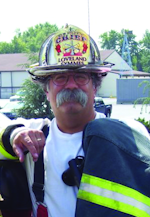
Billy Goldfeder
BILLY GOLDFEDER, EFO, who is a Firehouse contributing editor, has been a firefighter since 1973 and a chief officer since 1982. He is deputy fire chief of the Loveland-Symmes Fire Department in Ohio, which is an ISO Class 1, CPSE and CAAS-accredited department. Goldfeder has served on numerous NFPA and International Association of Fire Chiefs (IAFC) committees. He is on the board of directors of the IAFC Safety, Health and Survival Section and the National Fallen Firefighters Foundation.
